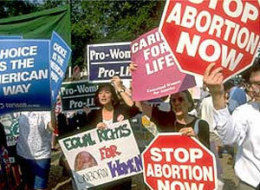Protesting Against Abortion: How Far Is Too Far?
 On May 31 of 2009, Dr. George Tiller was murdered while serving as an usher during a church service, due to the fact that he is one of the nation’s only late-term abortionists. This occurrence serves as one of the thousands of violent incidents performed in protest against abortion. Though it may seem like it was for the greater good, the end result, in Dr. Tiller’s case, was death, just as it would be for an aborted fetus. This raises questions about whether or not society should value one life above another. In the end, doing so would be both morally and lawfully wrong. Therefore, the government should enforce stricter laws in regards to the limits on protesting against abortion because it is an invasion of privacy, causes unwanted violence, and is a danger to society.
On May 31 of 2009, Dr. George Tiller was murdered while serving as an usher during a church service, due to the fact that he is one of the nation’s only late-term abortionists. This occurrence serves as one of the thousands of violent incidents performed in protest against abortion. Though it may seem like it was for the greater good, the end result, in Dr. Tiller’s case, was death, just as it would be for an aborted fetus. This raises questions about whether or not society should value one life above another. In the end, doing so would be both morally and lawfully wrong. Therefore, the government should enforce stricter laws in regards to the limits on protesting against abortion because it is an invasion of privacy, causes unwanted violence, and is a danger to society.
Dr. George Tiller was a frequent target for pro-life violence. He was such a frequent target, in fact, that his murder was not the first time he was held at gunpoint. In 1993, a woman shot both of his arms. On March 31, he died while serving at the Reformation Lutheran Church in Wickita, Kansas, his hometown. His killer, Scott Roeder, was caught the same day and charged with first-degree murder and two accounts of aggravated assault. Though the murder was condemned by groups on both sides of the issue, many pro-life organizations had other thoughts. Anti-abortionist radio host and minister Wiley Drake stated, “I am glad George Tiller is dead." On the other hand, President Barack Obama was outraged by the killing, saying that, “However profound our differences as Americans over difficult issues such as abortion, they cannot be resolved by heinous acts of violence." This occurance is one of the thousands violent protests against abortion.
There are four categories of privacy rights. The second category states that it violates an individual’s privacy rights if someone “invades a private space in which the claimant has a reasonable expectation of privacy” (Hoffman). Protesting outside abortion clinics is a violation of the woman’s and the abortionist’s privacy rights. For this reason, there should be limits on how much protesting is permitted in front of clinics. It is often argued that protesting is exercising the individual’s right to freedom of speech; however, by doing this, another law is broken. The government cannot pick and choose in regards to what laws they can allow to be broken without punishment. They have to enforce all laws and, when broken, penalize offenders.
Furthermore, with more limits on abortion protesting, a lot of extreme violence would be contained. From 1989 to 2004, there were twenty-four attempted and successful murders, and even more bombings, arson attacks, bomb and death threats, assault, burglary, hate mail, picketing and vandalism (Religious Tolerance). Also, in a span of five years (1998-2002) there was 654 letters threatening Anthrax attacks (National Abortion Federation, Anthrax). With more laws to enforce a more peaceful type of protesting, the level of violent forms of protest would decrease dramatically, which would then decrease the amount of danger surrounding both the patients and providers. Though not all protests have violent outcomes, some do, and therefore the government needs to stop them someway. It is especially important for the government to put laws around abortion protesting because more often than not, those protests are the ones that result in violent outbreaks.
For the sake of surrounding businesses, issues of privacy rights, and prevention of violence, it would be wise for the government to enforce stricter laws regarding abortion protests.
Latest articles
-

Charleston Church Shooting
July 1st, 2015 at 12:28am
-

Lolita Fashion
September 22nd, 2014 at 07:56am
-

Exploring Asexuality
September 5th, 2014 at 02:02am
-

Should Flights Into Israel Be Stopped?
July 23rd, 2014 at 06:33pm
-

Bring Back Our Girls
May 7th, 2014 at 11:45pm
